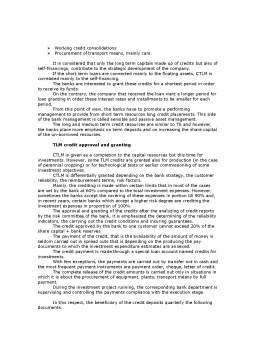Extras din referat
Risk of credit banks
In general, the risk is an future and probable event, whose occurrence would produce loss.
The bank risk is the phenomenon that could appear on the course of running the bank operations and which produce negative effects on bank activity and profit.
The bank credit implicitly involves the acceptance of a risk, namely the risk of not repaying the credit, e.g. non-repaying of the due installment and the afferent interests.
The bank risk involves the investigation of all its components and namely:
- Transaction risk (the functional and operational aspects of the business)
- Customer risk (his capacity to pay his debts to the banks)
- Guarantee risk (the bank possibility to recover its debts from guarantee revaluation)
The bank risk has the following structure:
- level 1 – named the customer and the transaction which comprises:
o financial and non-financial aspects
o nature and structure of the transaction
- level 2 – credit portfolio of the bank (on crediting objects for the working capital and separately for non-performing credit)
In the world there are many techniques and methods of estimating and quantifying the credit risk:
One of the most used analysis methods is called swot and comprises:
- hard points
- weak points
- opportunities and possibilities
- dangers and threats
From this method derives also the score method used in Romanian banks.
Types of bank risk:
1. Credit risk
2. Capital loss risk
3. Immobilization risk
4. Interest modification risk
5. Erosion by inflation risk
6. Investment risk
7. Contribution to portfolio risk
8. Operations risk
9. Fraud risk
10. Syndicating risk
11. Currency risk
12. Country risk
In our country also there are used estimating schemes and models for the credit risk.
Among the most used is the scheme of 5 c:
- capacity (possibility to pay)
- character (the will of the payers)
- capital (loan fortune)
- collateral (their guarantees + assurances)
- conditions (economical, social, internal, external)
Factors influencing the credit risk
- person factors (management, authority, panic)
- economical factors (general economic state, stock state and activity sector state from which the credit applicant belongs)
- financial factors (the financial state of the applicant, financial reliability indicators and prognoses for the period of credit granting)
- other factors (bank cooperation with the customer in the previous period, credit structure and resources, possibilities of reimbursing, credit object).
Romanian banks worked out potential norms in which the risk factors are quantified and estimated
In the Romanian bank methodological norms, the following risk factors and symptoms are compulsory found:
Risk factors:
- the business volume outsized compared to the existing possibilities (uncontrolled expansion)
- inadequate structure of the capital (the existence of a too high capital in fix assets and too low in circulatory assets)
- inadequate capitalization (very low reinvested profit)
- too high or too many investment projects in work
Risk symptoms:
- financial signals (delayed payments, stock increase)
- creative accountancy (the synthetic indicators does not exist in the analytical evidence)
- non-financial signals (quality refusals, unobserving the contractual terms)
- non-financial signals (repeated commissions of the management, rumours, frequent actions of the justice)
Bank credit interest
The interest concept
The interest is a complex concept because it has implications and connections to other concepts (capital, risk, profit)
Generally, the credit in granted with interest. This represents the remuneration of using the borrowed capital.
Like the credit, a long period of time, the interest was regarded with aversion, because of the usury which represented the form of interest received at the time for loans.
The interest is a form of profit, so that it is extensively treated in the value theory and utility theory.
The interest represents a remuneration received by the banks, by the company or by the natural person, borrowed for making available a capital, on a given period.
Interest types:
- For the lender, the interest is a credit one, e.g. represents a debt, an amount to be received
- For the borrower, the interest is a credit one, a debt to be paid
- Gross interest, net interest (depending on the stage in which the interest tax is paid)
- Active interest, passive interest. These interests are similar to earned interest and credit interest with the difference that the bank receives the interest from the credits (active interest) but also is paying interests (passive interest) for the attracted resources
- Inter-banking interest is applied for the credits granted between banks
- Moratory interest or penalty interest is the one legally owed or agreed upon between banks and the customer in case, at the term of payment, the current interest it is not reimbursed.
- The intermediary interest is the one referring to a date which is not in term of payment
Preview document
Conținut arhivă zip
- Bank Risk.doc



















